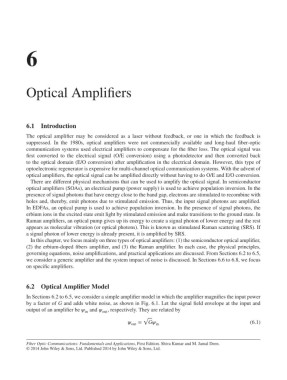Page 266 - Fiber Optic Communications Fund
P. 266
6
Optical Amplifiers
6.1 Introduction
The optical amplifier may be considered as a laser without feedback, or one in which the feedback is
suppressed. In the 1980s, optical amplifiers were not commercially available and long-haul fiber-optic
communication systems used electrical amplifiers to compensate for the fiber loss. The optical signal was
first converted to the electrical signal (O/E conversion) using a photodetector and then converted back
to the optical domain (E/O conversion) after amplification in the electrical domain. However, this type of
optoelectronic regenerator is expensive for multi-channel optical communication systems. With the advent of
optical amplifiers, the optical signal can be amplified directly without having to do O/E and E/O conversion.
There are different physical mechanisms that can be used to amplify the optical signal. In semiconductor
optical amplifiers (SOAs), an electrical pump (power supply) is used to achieve population inversion. In the
presence of signal photons that have energy close to the band gap, electrons are stimulated to recombine with
holes and, thereby, emit photons due to stimulated emission. Thus, the input signal photons are amplified.
In EDFAs, an optical pump is used to achieve population inversion. In the presence of signal photons, the
erbium ions in the excited state emit light by stimulated emission and make transitions to the ground state. In
Raman amplifiers, an optical pump gives up its energy to create a signal photon of lower energy and the rest
appears as molecular vibration (or optical photons). This is known as stimulated Raman scattering (SRS). If
a signal photon of lower energy is already present, it is amplified by SRS.
In this chapter, we focus mainly on three types of optical amplifiers: (1) the semiconductor optical amplifier,
(2) the erbium-doped fibers amplifier, and (3) the Raman amplifier. In each case, the physical principles,
governing equations, noise amplifications, and practical applications are discussed. From Sections 6.2 to 6.5,
we consider a generic amplifier and the system impact of noise is discussed. In Sections 6.6 to 6.8, we focus
on specific amplifiers.
6.2 Optical Amplifier Model
In Sections 6.2 to 6.5, we consider a simple amplifier model in which the amplifier magnifies the input power
by a factor of G and adds white noise, as shown in Fig. 6.1. Let the signal field envelope at the input and
output of an amplifier be and , respectively. They are related by
in out
√
= G (6.1)
out in
Fiber Optic Communications: Fundamentals and Applications, First Edition. Shiva Kumar and M. Jamal Deen.
© 2014 John Wiley & Sons, Ltd. Published 2014 by John Wiley & Sons, Ltd.

